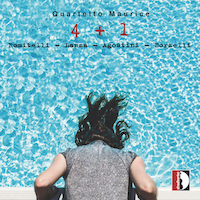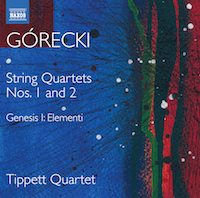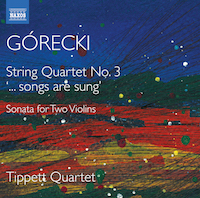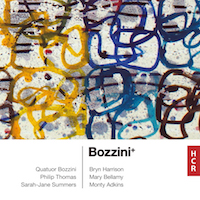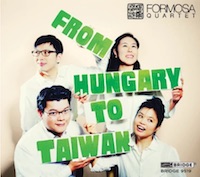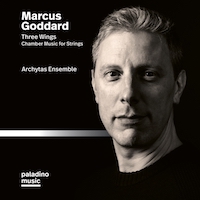String Theory 32: Quartets, plus or minus
|
Grant Chu Covell [August 2020.]
“4+1.” Fausto ROMITELLI: Natura morta con fiamme (1991). Mauro LANZA: The 1987 Max Headroom Broadcast Incident (2017). Andrea AGOSTINI: Legno sabbia vetro cenere (2009-10). Silvia BORZELLI: Earwitness (familiar 2) (2017). Quartetto Maurice: Georgia Privitera, Laura Bertolino (vln), Francesco Vernero (vla), Aline Privitera (vlc). Stradivarius STR 37105 (1 CD) (http://www.stradivarius.it/). Electricity and fire pervade this release. Romitelli’s “Still life with flames” is the anchoring classic, the unified strings squirming against electronic contours as if a two-part duet. Lanza’s piece is dedicated to Romitelli. It’s based on a freakish event, the true hijacking of a TV broadcast by a character pretending to be Max Headroom (Nov. 22, 1987). We hear broadcast effects (static, a tape deck coming alive), stuttering typical of the character, and bits of the pirate signal. The quartet courses over the electronic effects like ice water, eventually synchronizing in a rapid choreography. Agostini and Borzelli also stand in Romitelli’s shadow. These last two pieces complement each other as if meant to be a two-part structure. Agostini’s initial agitation yields to statis, as the quartet’s rapid descending scales become slowed by an expanding tape. Reflecting Elias Canetti’s 1974 collection of written portraits, Earwitness, Borzelli has the four strings elicit short phrases and sparse notes, but these patterns repeat and subtly accelerate over a tape consisting primarily of field recordings.
Henryk Mikołaj GÓRECKI: String Quartet No. 1, Op. 62, “Already it is Dusk” (1988)1; Genesis I: Elementi, Op. 19, No. 1 (1962)2; String Quartet No. 2, Op. 64, “Quasi una fantasia” (1991)3. Tippett Quartet: John Mills1,2,3, Jeremy Isaac1,3 (vln), Lydia Lowndes-Northcott1,2,3 (vla), Bozidar Vukotic1,2,3 (vlc). Naxos 8.573919 (1 CD) (http://www.naxos.com/). Henryk Mikołaj GÓRECKI: Sonata for Two Violins, Op. 10 (1957)1; String Quartet No. 3, Op. 67, “…songs are sung” (1995; rev. 2005)2. Tippett Quartet: John Mills1,2, Jeremy Isaac1,2 (vln), Lydia Lowndes-Northcott2 (vla), Bozidar Vukotic2 (vlc). Naxos 8.574110 (1 CD) (http://www.naxos.com/). Górecki no longer shocks. We’re ready to stare down his piquant mix of harsh, satiric and sweet. When required, the Tippetts offer some of the most heartless music making appropriate for this weary music. No. 2 is executed grimly. Do we laugh or cry when the familiar carol appears towards the end? No. 3 continues the slow burn through barren melancholic fields but can be disarmingly affectionate as in the central Allegro. The filler pieces predate the quartets. Exploring mid-century aleatoric motions (glissandos, scratches, etc.), Genesis I: Elementi is hardly a softer string trio, and the two-violin Sonata is unendingly strident. How do the Tippetts possess such sympathy for Górecki? (Alwyn and Tippett are unexpected springboards for Górecki.) This quartet should look at Schnittke’s pages.
“Bozzini+.” Bryn HARRISON: Piano Quintet (2017)1. Mary BELLAMY: beneath an ocean of air (2017)2. Monty ADKINS: Still Juniper Snow (2018)3. Philip Thomas1,2 (pno), Sara-Jane Summers3 (fiddle), Quatuor Bozzini1,2,3: Clemens Merkel, Alissa Cheung (vln), Stéphanie Bozzini (vla), Isabelle Bozzini (vlc). Huddersfield Contemporary Records HCR19CD (2 CDs) (https://research.hud.ac.uk/institutes-centres/cerenem/hcr/). Harrison’s hour-long Piano Quintet is much like watching a swirling paint box. Because of the quintet’s scale, late orchestral Feldman is a clear precursor (Coptic Light, etc.), however, Harrison’s agitated flavors (slides, note fields) are crunchier. We’re meant to consider memory and time passing. Perhaps it’s coincidence or a lark, but there’s a repeated piano passage suggesting a music-box tune. Bellamy’s quintet functions within a more comprehensible span (22:39), the piano hiding beneath feathery glissandos and microtones. In this quintet, we’re asked to look through sculptural windows and see sky and passing clouds. Augmenting the Bozzinis is this release’s concept: With piano in the Harrison and Bellamy and with fiddle and electronics in the Adkins. Still Juniper Snow is an electroacoustic work derived from the quartet and fiddler’s exploration of Scottish and Norwegian tunes. In three movements which evaporate unexpectedly, the quartet and fiddler hover and coalesce through dreamy transformations.
“From Hungary to Taiwan.” Dana WILSON: Hungarian Folk Songs (2008). Lei LIANG: Song Recollections (2016). Béla BARTÓK: String Quartet No. 4 (1928). Wei-Chieh LIN: Four Taiwanese Folk Songs (2017). Formosa Quartet: Jasmine Lin, Wayne Lee (vln), Che-Yen Chin (vla), Deborah Pae (vlc). Bridge 9519 (1 CD) (http://www.bridgerecords.com/). This program engages us with mutable folk songs, reminding us that despite the composer’s want for preservation, composed arrangements evolve into something new that can no longer be claimed by their original culture. Hungarian folk tunes are more familiar within the context of Western music, and so Wilson’s eight precision settings with indicated inflections and notated vibrato fills gaps in a genre we think we know. But even in Bartók and Kodály’s day, the originals were evaporating. By comparison, the Chinese and Taiwanese songs are exotic, easily located by a Western ear in the Orient. However, Taiwan’s political history suggests even these songs are not what they seem, and the Cultural Revolution broke the lineage of Chinese folk songs’ transmission. Liang’s atmospheric Song Recollections unfold easily as once folkloric material mutates dreamily even harshly: Tunes are lightly shredded, aspects repeated as if misremembered or perhaps as attempts to preserve. Lin’s Taiwanese Folksongs are sweet and lyrical, one can imagine them standing in as arrangements from the 20s. (A fifth song can be downloaded or streamed as a bonus track.) The Formosas (the quartet employs a short-lived name for Taiwan, controversial and historic) tackle the songs with delicacy and attention to detail. Who hears Hungarian tunes in Bartók’s Fourth, that anchoring landmark of 20th-century quartet repertoire? Honestly, the Bartók jars. An essential, unforgettable masterpiece has become foreign which is quite a feat. If far less aggressive than other readings, it is easier to hear voices from the past whether Bartók himself or the musicians whom he and Kodály recorded long ago.
Marcus GODDARD: Allaqi (2009)1; Wind, Sand & Stars (2011)2; Three Wings (2016)3. Archytas Ensemble: Dale Barltrop1,3, David Gillham1,2,3 (vln), David Harding1,2,3 (vla), Ariel Barnes1,2,3 (vlc). Paladino Music mpr 0079 (1 CD) (http://www.paladino.at/). Goddard’s balanced program features two quartets and a trio, with just enough 21st-century challenges. Inspired by Inuit throat singing, Allaqi introduces rough motions, definitely neither atonal nor arrhythmic, but bathed in minor-mode lyric dissonance. This material is energetically balanced against harmonized tunes that reside in that folksy terrain between Dvorak and Copland, recalling the works Volans wrote for the Kronos decades ago. A trio, Wind, Sand & Stars, explores the desert of Antoine de Saint-Exupéry’s memoir. Goddard’s agitated style suggests Shostakovich’s motor rhythmic teeth grinding. In Three Wings, melodies become shrill as they evade traditional harmony. Must all loud, slow and high string music evoke Barber’s Adagio? The title borrows a line from O Virtus Sapientiae by Hildegard von Bingen.
Adkins, Agostini, B Harrison, Bartók, Bellamy, Borzelli, D Wilson, Górecki, Lanza, Lei Liang, M Goddard, Romitelli, Wei-Chieh Lin
[More
Adkins, Agostini, B Harrison, Bartók, Bellamy, Borzelli, D Wilson, Górecki, Lanza, Lei Liang, M Goddard, Romitelli, Wei-Chieh Lin]
[Previous Article:
My Favorite Morricone]
[Next Article:
Music in the Midst of the Plague: A Conversation with Beth Levin]
|
